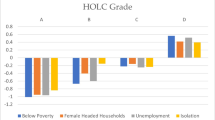Abstract
Seattle deploys several mechanisms by which individuals’ presence in particular spaces can constitute a crime. Through a range of means, police in Seattle are given wide authority to question and arrest those who appear as human manifestations of the “disorder” that is of concern to many. Importantly, these programs accentuate the power of criminal law by mobilizing other forms of law, most notably civil law and administrative law. This legally-hybrid structure works to accentuate the police’s power notably. Yet increased police power does not actually work to reduce “disorder” to any appreciable extent. For this reason, and others, we suggest that different approaches to addressing social marginality represent more promising avenues for cities like Seattle to explore.
Similar content being viewed by others
Notes
References
Adamson, C. R. (1983). Punishment After Slavery. Social Problems, 30(5), 493–507.
Adler, J. S. (1989). A Historical Analysis of the Law of Vagrancy. Criminology, 27(2), 209–229.
Allan, E. L. (2004). Civil gang abatement: The effectiveness and implications of policing by injunction. New York: LFB Scholarly.
Beckett, K., & Herbert, S. (2009). Banished: The new social control in urban America. Oxford and New York: Oxford University Press.
Beier, A. L. (1985). Masterless Men: The Vagrancy Problem in England 1560-1640. New York: Methuen.
Dolbeare, C., Saraf, I., & Crowley, S. (2004). Changing priorities: The federal budget and housing assistance, 1976-2004. Washington D.C: National Low Income Housing Coalition.
Ellickson, R. (1996). Controlling chronic misconduct in city spaces: of panhandlers, skid rows, and public-space zoning. Yale Law Journal, 105, 1165–1214.
Feldman, L.C. (2004) Citizens Without Shelter: Homelessness, Democracy and Political Exclusion. Cornell University Press.
Flanagan, P. (2003). Trespass-zoning: ensuring neighborhoods a safer future by excluding those with a criminal past,”. Notre Dame Law Review, 79, 327–379.
Gibson, T. (2004). Securing the Spectacular City: The Politics of Revitalization and Homelessness in Downtown Seattle. Lanham: Lexington Books.
Goldstein, E. (2003). Kept out: responding to public housing No-trespass policies. Harvard Civil Rights and Civil Liberties Journal, 38, 215–245.
Greenspan, R. (1994). Criminal Due process in the administrative state. Studies in Law, Politics & Society, 14, 169–211.
Harrison, B. (1988). The great U-turn: Corporate restructuring and the polarizing of America. New York: Basic Books.
Herbert, S. (1997). Policing space: territoriality and the Los Angeles Police Department. Minneapolis: University of Minnesota Press.
Herbert, S. (2011). The paradoxes of social control in Seattle. In M. Brown & R. Morrill (Eds.), Seattle Geographies. Seattle: University of Washington Press.
Hill, G. (2005). The Use of Pre-Existing Exclusionary Zones as Pobationary Conditions for Prostitution Offenses: a Cal for the Sincere Application of Heightened Scrutiny. Seattle University Law Review, 28, 1024–1072.
Larimer, M. E., Malone, D. K., Garner, D., Atkins, D. C., Burlingham, B., Lonczak, H. S., Tanzer, K., Ginzler, J., Clifasefi, S. L., Hobson, W. G., & Marlatt, A. (2009). Health Care and Public Service Use and Costs Before and After Provision of Housing for Chronically Homeless Persons With Severe Alcohol Problems. JAMA, 301(13), 1349–1357.
Lees, L., Slater, T., & Wyly, E. (2008). Gentrification. New York: Routledge.
Maher, L., & Dixon, D. (1999). Policing and public health: Law enforcement and harm minimization in a street-level drug market. British Journal of Criminology, 39, 488–512.
Marlatt, A. G. (2002). Harm Reduction: Pragmatic Strategies for Managing High-Risk Behaviors. New York: Guilford Press.
Mitchell, D. (2006) Property rights, the first amendment, and judicial anti-urbanism: the strange case of Hicks v. Virginia. Urban Geography, 26, 565–586.
Roberts, D. (1999). Race, Vagueness, and the Social Meaning of Order-Maintenance Policing. The Journal of Criminal Law and Criminology, 89, 775–836.
Sack, R. (1986). Human territoriality: Its theory and history. Cambridge: Cambridge University Press.
Smith, N. (1996). The new urban frontier: Gentrification and the revanchist city. New York: Routledge.
Stewart, G. (1998). Black Codes and Broken Windows: the Legacy of Racial Hegemony in Anti-Gang Civil Injunctions. The Yale Law Journal, 107(7), 2249–2280.
Tsemberis, S. (2004). Housing First. Encyclopedia of Homelessness (pp. 277–280). Thousand Oaks: Sage.
White, A.A. (2004). A Different Kind of Labor Law: Vagrancy Law and the Regulation of Harvest Labor, 1913-1924. 75 University of Colorado Law Review 667.
Wilson, J.Q., & Kelling, G. (1982). The police and neighborhood safety. Atlantic Monthly May: 28-38.
Wolch, J., & Dear, M. (1987). Landscapes of despair: From deinstitutionalization to homelessness. Princeton: Princeton University Press.
Author information
Authors and Affiliations
Corresponding author
Rights and permissions
About this article
Cite this article
Herbert, S., Beckett, K. Banishment and the Post-Industrial City: Lessons from Seattle. Eur J Crim Policy Res 23, 27–40 (2017). https://doi.org/10.1007/s10610-016-9316-z
Published:
Issue Date:
DOI: https://doi.org/10.1007/s10610-016-9316-z




